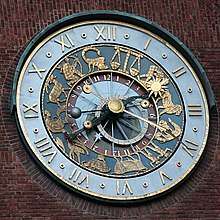Astronomical clock
An astronomical clock, horologium, or orloj is a clock with special mechanisms and dials to display astronomical information, such as the relative positions of the sun, moon, zodiacal constellations, and sometimes major planets.
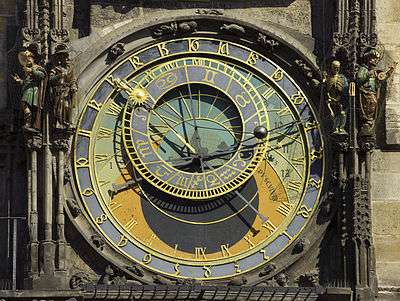
Definition
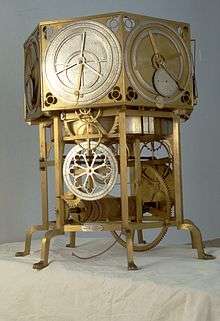
The term is loosely used to refer to any clock that shows, in addition to the time of day, astronomical information. This could include the location of the sun and moon in the sky, the age and Lunar phases, the position of the sun on the ecliptic and the current zodiac sign, the sidereal time, and other astronomical data such as the moon's nodes (for indicating eclipses) or a rotating star map. The term should not be confused with astronomical regulator, a high precision but otherwise ordinary pendulum clock used in observatories.
Astronomical clocks usually represent the solar system using the geocentric model. The center of the dial is often marked with a disc or sphere representing the earth, located at the center of the solar system. The sun is often represented by a golden sphere (as it initially appeared in the Antikythera Mechanism, back in the 2nd century BC), shown rotating around the earth once a day around a 24-hour analog dial. This view accorded both with the daily experience and with the philosophical world view of pre-Copernican Europe.
History

Research in 2011 and 2012 led an expert group of researchers to posit that European astronomical clocks are descended from the technology of the Antikythera mechanism.[1]
In the 11th century, the Song dynasty Chinese horologist, mechanical engineer, and astronomer Su Song created a water-driven astronomical clock for his clock-tower of Kaifeng City. Su Song is noted for having incorporated an escapement mechanism and earliest known endless power-transmitting chain drive for his clock-tower and armillary sphere to function. Contemporary Muslim astronomers and engineers also constructed a variety of highly accurate astronomical clocks for use in their observatories,[2][3] such as the castle clock (a water-powered astronomical clock) by Al-Jazari in 1206,[4] and the astrolabic clock by Ibn al-Shatir in the early 14th century.[5]
The early development of mechanical clocks in Europe is not fully understood, but there is general agreement that by 1300–1330 there existed mechanical clocks (powered by weights rather than by water and using an escapement) which were intended for two main purposes: for signalling and notification (e.g. the timing of services and public events), and for modelling the solar system. The latter is an inevitable development, because the astrolabe was used both by astronomers and astrologers, and it was natural to apply a clockwork drive to the rotating plate to produce a working model of the solar system. American historian Lynn White Jr. of Princeton University wrote:[6]
Most of the first clocks were not so much chronometers as exhibitions of the pattern of the cosmos … Clearly the origins of the mechanical clock lie in a complex realm of monumental planetaria, equatoria, and geared astrolabes.
The astronomical clocks developed by the English mathematician and cleric Richard of Wallingford in St Albans during the 1330s,[7] and by medieval Italian physician and astronomer Giovanni de Dondi in Padua between 1348 and 1364[8] are masterpieces of their type. They no longer exist, but detailed descriptions of their design and construction survive, and modern reproductions have been made. Wallingford's clock may have shown the sun, moon (age, phase, and node), stars and planets, and had, in addition, a wheel of fortune and an indicator of the state of the tide at London Bridge. De Dondi's clock was a seven-faced construction with 107 moving parts, showing the positions of the sun, moon, and five planets, as well as religious feast days.[8]
Both these clocks, and others like them, were probably less accurate than their designers would have wished. The gear ratios may have been exquisitely calculated, but their manufacture was somewhat beyond the mechanical abilities of the time, and they never worked reliably. Furthermore, in contrast to the intricate advanced wheelwork, the timekeeping mechanism in nearly all these clocks until the 16th century was the simple verge and foliot escapement, which had errors of at least half an hour a day.
Astronomical clocks were built as demonstration or exhibition pieces, to impress as much as to educate or inform. The challenge of building these masterpieces meant that clockmakers would continue to produce them, to demonstrate their technical skill and their patrons' wealth. The philosophical message of an ordered, heavenly-ordained universe, which accorded with the Gothic era view of the world, helps explain their popularity.
The growing interest in astronomy during the 18th century revived interest in astronomical clocks, less for the philosophical message, more for the accurate astronomical information that pendulum-regulated clocks could display.
Generic description
Although each astronomical clock is different, they share some common features.[9]
Time of day


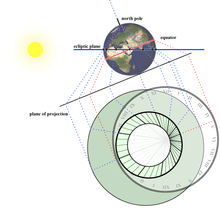
Most astronomical clocks have a 24-hour analog dial around the outside edge, numbered from I to XII then from I to XII again. The current time is indicated by a golden ball or a picture of the sun at the end of a pointer. Local noon is usually at the top of the dial, and midnight at the bottom. Minute hands are rarely used.
The sun indicator or hand gives an approximate indication of both the sun's azimuth and altitude. For azimuth (bearing from north), the top of the dial indicates South, and the two VI points of the dial East and West. For altitude, the top is the zenith and the two VI and VI points define the horizon. (This is for the astronomical clocks designed for use in the northern hemisphere.) This interpretation is most accurate at the equinoxes, of course.
If XII is not at the top of the dial, or if the numbers are Arabic rather than Roman, then the time may be shown in Italian hours (also called Bohemian, or Old Czech, hours). In this system, 1 o'clock occurs at sunset, and counting continues through the night and into the next afternoon, reaching 24 an hour before sunset.
In the photograph of the Prague clock shown above, the time indicated by the sun hand is about noon (XII in Roman numerals), or about the 17th hour (Italian time in Arabic numerals).
Calendar and zodiac
The year is usually represented by the 12 signs of the zodiac, arranged either as a concentric circle inside the 24-hour dial, or drawn onto a displaced smaller circle, which is a projection of the ecliptic, the path of the sun and planets through the sky, and the plane of the Earth's orbit.
The ecliptic plane is projected onto the face of the clock, and, because of the Earth's tilted angle of rotation relative to its orbital plane, it is displaced from the center and appears to be distorted. The projection point for the stereographic projection is the North pole; on astrolabes the South pole is more common.
The ecliptic dial makes one complete revolution in 23 hours 56 minutes (a sidereal day), and will therefore gradually get out of phase with the hour hand, drifting slowly further apart during the year.
To find the date, find the place where the hour hand or sun disk intersects the ecliptic dial: this indicates the current star sign, the sun's current location on the ecliptic. The intersection point slowly moves round the ecliptic dial during the year, as the sun moves out of one astrological sign into another.
In the diagram showing the clock face on the right, the sun's disk has recently moved into Aries (the stylized ram's horns), having left Pisces. The date is therefore late March or early April.
If the zodiac signs run around inside the hour hands, either this ring rotates to align itself with the hour hand, or there's another hand, revolving once per year, which points to the sun's current zodiac sign.
Moon
A dial or ring indicating the numbers 1 to 29 or 30 indicates the moon's age: a new moon is 0, waxes and become full around day 15, and then wanes up to 29 or 30. The phase is sometimes shown by a rotating globe or black hemisphere, or a window that reveals part of a wavy black shape beneath.
Hour lines
Unequal hours were the result of dividing up the period of daylight into 12 equal hours, and night time into another 12. In Europe, there is more daylight in the summer, and less night, so each of the 12 daylight hours is longer than a night hour. Similarly in winter, daylight hours are shorter, and night hours are longer. These unequal hours are shown by the curved lines radiating from the center. The longer daylight hours in summer can usually be seen at the outer edge of the dial, and the time in unequal hours is read by noting the intersection of the sun hand with the appropriate curved line.
Aspects
Astrologers placed importance on how the sun, moon, and planets were arranged and aligned in the sky. If certain planets appeared at the points of a triangle, hexagon, or square, or if they were opposite or next to each other, the appropriate aspect was used to determine the event's significance. On some clocks you can see the common aspects—triangle, square, and hexagon—drawn inside the central disk, with each line marked by the symbol for that aspect, and you may also see the signs for conjunction and opposition. On an astrolabe, the corners of the different aspects could be lined up on any of the planets. On a clock, though, the disk containing the aspect lines can't be rotated at will, so they usually show only the aspects of the sun or moon.
In the photograph of the Brescia clock above, the triangle, square, and star in the center of the dial show these aspects (the third, fourth, and sixth phases) of (presumably) the moon.
Dragon hand: eclipse prediction and lunar nodes
The moon's orbit is not in the same plane as the Earth's orbit around the sun, but crosses it in two places. The moon crosses the ecliptic plane twice a month, once when it goes up above the plane, and again 15 or so days later when it goes back down below the ecliptic. These two locations are the ascending and descending lunar nodes. Solar and lunar eclipses will occur only when the moon is positioned near one of these nodes, because at other times the moon is either too high or too low for an eclipse to be noticed from earth. Some astronomical clocks keep track of the position of the lunar nodes with a long pointer that crosses the dial. This so-called dragon hand makes one complete rotation around the ecliptic dial every 19 years. When the dragon hand and the new moon coincide, the moon is on the same plane as the earth and sun, and so there is every chance that an eclipse will be visible from somewhere on earth.
Historical examples
Su Song's Cosmic Engine
The Science Museum (London) has a scale model of the 'Cosmic Engine', which Su Song, a Chinese polymath, designed and constructed in China in 1092. This great astronomical hydromechanical clock tower was about ten metres high (about 30 feet) and featured a clock escapement and was indirectly powered by rotating wheel either with falling water and liquid mercury, which freezes at a much lower temperature than water, allowing operation of the clock during colder weather. A full-sized working replica of Su Song's clock exists in the Republic of China (Taiwan)'s National Museum of Natural Science, Taichung city. This full-scale, fully functional replica, approximately 12 meters (39 feet) in height, was constructed from Su Song's original descriptions and mechanical drawings.[10]
Al-Jazari's castle clock
The most sophisticated water-powered astronomical clock was Al-Jazari's castle clock, considered to be an early example of a programmable analog computer, in 1206. It was a complex device that was about 33 meters (108 feet) high, and had multiple functions alongside timekeeping. It included a display of the zodiac and the solar and lunar orbits, and a pointer in the shape of the crescent moon which travelled across the top of a gateway, moved by a hidden cart and causing automatic doors to open, each revealing a mannequin, every hour.[11][12][13][14]
It was possible to re-program the length of day and night every day in order to account for the changing lengths of day and night throughout the year, and it also featured five musician automata who automatically played music when moved by levers operated by a hidden camshaft attached to a water wheel.[15] Other components of the castle clock included a main reservoir with a float, a float chamber and flow regulator, plate and valve trough, two pulleys, crescent disc displaying the zodiac, and two falcon automata dropping balls into vases.[16]
Astronomical clock of Taqi al-Din
The Ottoman engineer Taqi al-Din described a weight-driven clock with a verge-and-foliot escapement, a striking train of gears, an alarm, and a representation of the moon's phases in his book The Brightest Stars for the Construction of Mechanical Clocks (Al-Kawākib al-durriyya fī wadh' al-bankāmat al-dawriyya), written around 1565.[17] The clock also displayed the zodiac.
Interior clocks and watches
The Rasmus Sørnes Clock

Arguably the most complicated of its kind ever constructed, the last of a total of four astronomical clocks designed and made by Norwegian Rasmus Sørnes (1893–1967), is characterized by its superior complexity compactly housed in a casing with the modest measurements of 0.70 x 0.60 x 2.10 m. Features include locations of the sun and moon in the zodiac, Julian calendar, Gregorian calendar, sidereal time, GMT, local time with daylight saving time and leap year, solar and lunar cycle corrections, eclipses, local sunset and sunrise, moonphase, tides, sunspot cycles and a planetarium including Pluto's 248-year orbit and the 25 800-year period of the polar ecliptics (precession of the Earth's axis). All wheels are in brass and gold-plated. Dials are silver-plated. The clock has an electromechanical pendulum.
Sørnes also made the necessary tools and based his work on his own astronomical observations. Having been exhibited at the Time Museum in Rockford, Illinois, and at The Chicago Museum of Science and Industry, the clock was sold in 2002 and its current location is not known. The Rasmus Sørnes Astronomical Clock No. 3, the precursor to the Chicago Clock, his tools, patents, drawings, telescope and other items, are exhibited at the Borgarsyssel Museum in Sarpsborg, Norway.
Table clocks
There are many examples of astronomical table clocks, due to their popularity as showpieces. To become a master clockmaker in 17th-century Augsburg, candidates had to design and build a 'masterpiece' clock, an astronomical table-top clock of formidable complexity. Examples can be found in museums, such as London's British Museum.
Currently Edmund Scientific among other retailers offer a mechanical Tellurium clock, perhaps the first mechanical astronomical clock to be mass marketed.
In Japan, Tanaka Hisashige made a Myriad year clock in 1851.
Watches
More recently, independent clockmaker Christiaan van der Klaauw created a wristwatch astrolabe, the "Astrolabium" in addition to the "Planetarium 2000", the "Eclipse 2001" and the "Real Moon." Ulysse Nardin also sells several astronomical wristwatches, the "Astrolabium," "Planetarium", and the "Tellurium J. Kepler."
 Christiaan van der Klaauw
Christiaan van der Klaauw
Planetarium 2000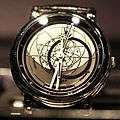 Ulysse Nardin Astrolabium Galileo Galilei
Ulysse Nardin Astrolabium Galileo Galilei Citizen Cosmosign
Citizen Cosmosign- Citizen Moonsign
Examples by country
Austria
- Innsbruck. The astronomical clock in the gable of 17–19 Maria-Theresien-Strasse is a 20th-century copy of the astronomical clock of the Ulm Rathaus.[18]
- Peuerbach. The facade of Peuerbach Town Hall features an astrolabe clock, an enlarged copy of Georg von Peuerbach's original astrolabe of 1457.[19]
Belgium
- Lier. The Zimmer tower houses an astronomical clock installed by Louis Zimmer in 1930. On twelve dials surrounding a central clockface, it gives indications including the time around the world, the date, the moon phase, and the equation of time, and includes a tide clock.
- Senzeilles. The Senzeilles astronomical clock was constructed by the self-taught Lucien Charloteaux between 1896 and 1912. A domestic clock housed in a wooden case, it gives indications including the solar, mean and sidereal time around the world, the positions of the constellations and planets, and the appearance of Halley's Comet.[20]
- Sint-Truiden. The astronomical clock constructed by Kamiel Festraets between 1937 and 1942 is now housed in the Festraets Museum in the Béguinage St. Agnès.
 Zimmertoren, Lier
Zimmertoren, Lier Sint-Truiden
Sint-Truiden
Croatia
- Dubrovnik. The Dubrovnik Bell Tower constructed in 1444 has housed a clock since its creation, though due to earthquake damage, both the tower and the clock were replaced in 1929. A rotating moon ball shows the lunar phase.
- Dubrovnik
Czech Republic
- Prague. The Prague astronomical clock at the Old Town Hall is one of the most famous astronomical clocks. The central section was completed in 1410, the calendar dial added in 1490. The clock was renovated after damage during World War II, and in 1979. On the hour, Death strikes the time, and the twelve apostles appear at the doors above the clock.
- Olomouc. The Olomouc astronomical clock at the Town Hall is a rare example of a heliocentric astronomical clock. Dated 1422 by legend, but first mentioned in historical in 1517, the clock was remodelled approximately once every century; in 1898 the astrolabe was replaced with a heliocentric model of the solar system. Badly damaged by the retreating German army in 1945, the clock was remodelled in socialist realism style in 1955, under the Communist government. The religious and royal figures were replaced with athletes, workers, farmers, scientists and other members of the proletariat.
- Litomyšl. The tower of the Old Town Hall has an art nouveau astronomical clock, installed in 1907.[21]
- Prostějov. The astronomical clock in the tower of the New Town Hall was installed in 1910.
- Kryštofovo Údolí. The Kryštofovo Údolí astronomical clock is a modern astronomical clock (inaugurated in 2008), built in a former electrical substation.
- Hojsova Stráž. An astronomical clock in the Bohemian Forest was inaugurated in 2017. It has a concentric dial showing the 24-hour time, the date and zodiac, and the moon phase, and a star map dial with a dragon hand, and indicates the time of sunrise and sunset.[22]
- Třebíč. At the Třebíč Astronomical Observatory, a modern astronomical clock which shows the time in world cities, the time of sunrise and sunset, the date and zodiac, and the orbits of the planets.
- Žatec. The Temple to Hops and Beer, a museum and amusement complex dedicated to beer, has an astronomical clock on which the zodiac indication illustrates the annual processes of beer production.[23]
.jpg) Prague
Prague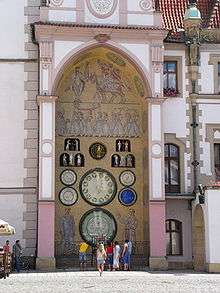 Olomouc
Olomouc- Prostějov
 Kryštofovo Údolí
Kryštofovo Údolí Hojsova Stráž
Hojsova Stráž Žatec
Žatec
Denmark
- Copenhagen. Jens Olsen's World Clock in Copenhagen City Hall was designed by Jens Olsen and assembled from 1948 to 1955.
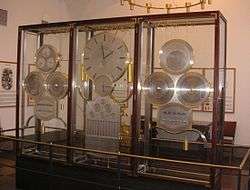 Jens Olsen's World Clock, Copenhagen
Jens Olsen's World Clock, Copenhagen
France
- Auxerre. The 15th-century clock in the Tour de l'Horloge has a 24-hour sun hand and a moon hand which completes a revolution in a lunar day of 24 hours 50 minutes, and shows the lunar phase on a rotating moon ball.
- Beauvais. The Beauvais astronomical clock in Beauvais Cathedral, constructed 1865–1868 by Auguste-Lucien Vérité, has 52 dials that display the times of sunrise, sunset, moonrise, moonset, the phases of the moon, the solstices, the position of the planets, the current time in 18 cities around the world, and the tidal hours. Its 68 automata enact the Last Judgement on the hour.
- Besançon. The astronomical clock in Besançon Cathedral (1860) was also constructed by Auguste-Lucien Vérité. Its 70 dials provide 122 indications.
- Bourges. The Bourges astronomical clock in Bourges Cathedral was installed in 1424. It shows the zodiac, and the moon phase and age.
- Chartres. The Chartres astronomical clock in Chartres Cathedral is an astrolabe clock, installed in 1528. It was overhauled, its mechanism replaced by an electric mechanism, in 2009.
- Haguenau. The facade of the Musée alsacien displays an astronomical clock, a modern copy of the clock of the Ulm Rathaus.
- Lyon. The Lyon astronomical clock in Lyon Cathedral was constructed in 1661, replacing a 14th-century original. It has an astrolabe dial and a calendar dial.
- Munster. The Church of Saint-Léger houses the Clock of Creation, installed in 2008. It shows the time, the day of the week, the month and zodiac, and the moon phase.[24]
- Ploërmel. The Ploërmel astronomical clock, constructed 1850–1855, comprises an astromical clock with 10 dials and an orrery.
- Rouen. The Gros Horloge has a movement built in 1389, with a dial added in 1529. It indicates the moon phase on a rotating sphere above the dial, and the day of the week in an aperture at the base of the dial.
- Saint-Omer. The Saint-Omer astronomical clock in Saint-Omer Cathedral is an astrolabe clock of 1558.
- Strasbourg. The Strasbourg astronomical clock is the third clock housed in Strasbourg Cathedral, following 14th-century and 16th-century predecessors. Constructed by Jean-Baptiste Schwilgué from 1838 to 1843, it shows many astronomical and calendrical functions (including what is thought to be the first complete mechanization of the computus needed to compute Easter) and several automata.
- Versailles. The Passemant astronomical clock in the Palace of Versailles near Paris is a rococo astronomical clock sitting on a formal low marble base. It took 12 years for a clockmaker and an engineer to build and was presented to Louis XV in 1754.
 Tour de l'Horloge, Auxerre
Tour de l'Horloge, Auxerre Bourges Cathedral
Bourges Cathedral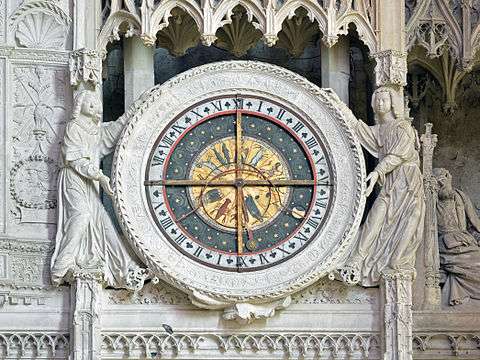 Chartres Cathedral
Chartres Cathedral Lyon Cathedral
Lyon Cathedral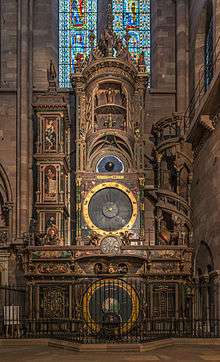 Strasbourg Cathedral
Strasbourg Cathedral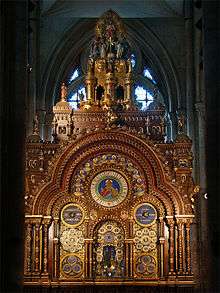 Beauvais Cathedral
Beauvais Cathedral
Georgia
- Batumi. The facade of the former National Bank Building on Europe Square has an astronomical clock based on the clock at Mantua, which shows the positions of the sun and moon in the zodiac, and the moon phase.[25]
Germany
- A group of interior astronomical clocks of the 14th, 15th and 16th centuries in churches of Hanseatic League towns in northern Germany, known as the Hanseatic clocks (the group also includes the clock at Gdańsk, now in Poland).
- Bad Doberan. At Doberan Minster, an astrolabe clock installed by Nikolaus Lilienfeld in 1390. Only the dial survives, now positioned above the west door.
- Lübeck. The astronomical clock of St. Mary's Church, constructed 1561–1566, was destroyed in the bombing of Lübeck in 1942. The present clock is a replacement by Paul Behrens, installed in 1967.
- Münster. The astronomical clock of 1540 in Münster Cathedral, adorned with hand-painted zodiac symbols, which traces the movement of the planets, and plays a glockenspiel tune every noon.
- Rostock. The Rostock astronomical clock in St. Mary's Church dating from 1472, built by Hans Düringer. Clock with daily time, zodiac, moon phases, and month. With a dedicated electronic database[26] this clock is particularly well documented.
- Stendal. At St. Mary's Church, an astronomical clock of the 1580s, rebuilt in 1856 (and vandalized by the clockmaker), and restored in 1977.[27]
- Stralsund. At St. Nicholas' Church, an astrolabe clock installed by Nikolaus Lilienfeld in 1394.
- Wismar. The 15th-century astronomical clock in St. Mary's Church was destroyed by bombing in 1945.
- A group of 16th-century clocks on the facade of town halls in southern Germany, which have a 12-hour dial, a moon phase indication, and a calendar dial indicating the positions of the sun and moon in the zodiac, with a dragon hand:
- Esslingen am Neckar. The Clock of Esslingen Old Town Hall, constructed 1581–1586.
- Heilbronn. The Kunstuhr of Heilbronn Town Hall of Isaac Habrecht, installed 1579–1580.
- Tübingen. The clock of Tübingen Town Hall, installed in 1510.
- Ulm. The 16th-century astronomical clock of Ulm Town Hall has a 24-hour astrolabe format, although the zodiac is repeated as a rotating ring of gold sculptures, and the outer ring of the dial is a 12-hour chapter ring.
- Cologne. At the Cologne Planetarium, a modern astronomical clock which shows the hour in regular and sidereal time, the moon phase, positions of the sun and moon in the zodiac, and the rotation of the earth according to the geocentric model.[28]
- Esslingen am Neckar. At the headquarters of Festo, Professor Hans Scheurenbrand has constructed the Harmonices Mundi (named after Kepler's book of the same name), which consists of an astronomical clock, a world time clock, and a 74 bell glockenspiel.[29]
- Görlitz. Görlitz Town Hall and the Church of St Peter and St Paul both have 16th-century clocks which indicate the lunar phase.
- Munich. The Old Town Hall and the Deutsches Museum both have clocks which indicate the moon phase on a rotating ball, and the zodiac on a fixed ring within a 12-hour dial.
- Schramberg. The Town Hall has an astronomical clock installed in 1913.[30] Its indications are similar to the clock of Ulm (except that the outer hour ring is 24-hour), with an offset astrolabe ring repeated as a golden zodiac ring.
- Stuttgart. A modern clock in the tower of Stuttgart Town Hall shows the moon phase and the day of the week.
- Worms. The clock tower Worms Town Hall has a modern calendar dial which shows the month, the positions of the sun and moon in the zodiac, the moon phase, and has a dragon hand.
_1%2C_by_Klugschnacker_in_Wikipedia.jpg) St. Nicholas' Church, Stralsund
St. Nicholas' Church, Stralsund St. Mary's Church, Rostock
St. Mary's Church, Rostock Münster Cathedral
Münster Cathedral St. Mary's Church, Lübeck
St. Mary's Church, Lübeck.jpg) Ulm
Ulm Deutsches Museum, Munich
Deutsches Museum, Munich
Hungary
- Székesfehérvár: A modern astronomical clock with automata, at the Clock Museum.[31]
- Székesfehérvár
Italy
- Arezzo. The clock of the Palazzo della Fraternita dei Laici, installed in 1552, shows the moon phase and age.[32]
- Bassano del Grappa. 24-hour dial with zodiac indication on the Palazzo del Municipio, first installed in 1430, reconstructed by Bartolomeo Ferracina in 1747.[33]
- Brescia. Astronomical clock dated c. 1540–1550 in the Torre dell'Orologio.[34][35]
- Clusone. Fanzago's astronomical clock at the Palazzo Comunale, built by Pietro Fanzago in 1583.
- Cremona. The 16th-century astronomical clock of the Torrazzo, the bell tower of Cremona Cathedral, is the largest medieval clock in Europe.
- Macerata. An astronomical clock installed in the Torre Civica, a modern replica of the original clock of 1571, which shows the orbits of the planets.
- Mantua. Astronomical clock installed in 1473 in the Torre dell'Orologio of the Palazzo della Ragione.
- Merano. Clock tower at the entrance to Merano town cemetery, installed in 1908 by Philipp Hörz of Ulm,[36] with calendar dial showing the month, zodiac, and moon phase.
- Messina. The Messina astronomical clock in the tower of Messina Cathedral. Multi-dial clock equipped with complex automata. Constructed between 1930 and 1933 by the Ungerer Company of Strasbourg. It is one of the largest astronomical clocks in the world.
- Padua. 15th-century astronomical clock in the Torre dell'Orologio.
- Rimini. The clock tower on Piazza Tre Martiri has a calendar dial installed in 1750[37] showing the date, zodiac, and moon phase and age.
- Soncino. 24-hour dial with zodiac indication on the town hall. The terracotta zodiac dial dates from 1977.[38]
- Trapani. Astronomical clock of 1596 in the Porta Oscura, with a dial for the hours and the zodiac, and a lunar dial.[39]
- Venice. St Mark's Clock, in the clocktower on St Mark's Square, was built and installed by Gian Paulo and Gian Carlo Rainieri, father and son, between 1496 and 1499.
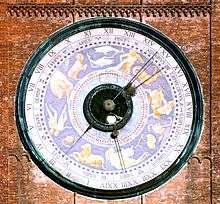 Cremona
Cremona- Mantua
 Brescia
Brescia Padua
Padua Venice
Venice- Messina
Latvia
- Riga: The clock on the facade of the House of the Blackheads shows the time, date, month, day of the week, and lunar phase.
 House of the Blackheads, Riga
House of the Blackheads, Riga
Malta
- Valletta. The clock of the Grandmaster's Palace, installed in 1745, shows the hour, date, month, and lunar phase, and has bells struck by four jacquemarts.[40]
- Malta has several church clocks which show calendar indications on separate dials, including those of St John's Co-Cathedral, Valletta; St Paul's Cathedral, Mdina; the Rotunda of Mosta; and the Church of St Bartholomew, Għargħur.[40]
 Grandmaster's Palace, Valletta
Grandmaster's Palace, Valletta
Netherlands
- Arnemuiden. The 16th-century church clock at Arnemuiden indicates the lunar phase and the time of high tide.
- Franeker. The Eise Eisinga Planetarium, built 1774–1781, is an orrery and astronomical clock which shows the movements of the solar system.
 Arnemuiden
Arnemuiden_(29621381347).jpg) Eise Eisinga Planetarium, Franeker
Eise Eisinga Planetarium, Franeker
Poland
- Gdańsk. In St. Mary's Church there is the Gdańsk astronomical clock dating from 1464 to 1470, and built by Hans Düringer of Toruń. It was reconstructed after 1945.
- Wrocław. A 16th-century clock showing the moon phase at Wrocław Town Hall.
.jpg) Gdańsk
Gdańsk Wrocław Town Hall
Wrocław Town Hall
Slovakia
- Stará Bystrica: An astronomical clock in the stylized shape of Our Lady of Sorrows was built in the town square in 2009. The astronomical part of the clock consists of an astrolabe displaying the astrological signs, positions of the Sun and Moon, and the lunar phases. Its statues and automata depict Slovakian historical and religious figures. The clock is controlled by computer using DCF77 signals.[41][42]
 Stará Bystrica
Stará Bystrica
Spain
- Astorga: The interior face of the clock of Astorga Cathedral has a 24-hour dial which shows the lunar phase and the date.[43]
Sweden
- Lund: The astronomical clock in Lund Cathedral in Sweden, Horologium mirabile Lundense was made around 1425, probably by the clockmaker Nicolaus Lilienveld in Rostock. After it had been in storage since 1837, it was restored and put back in place in 1923. Only the upper, astronomical part is original, while some of the other remaining medieval parts can be seen at the Cathedral museum. When it plays, one can hear In Dulci Jubilo from the smallest organ in the church, while seven wooden figures, representing the three magi and their servants, pass by.
- Rinkaby: An astronomical clock was installed in Rinkaby Church in the 1950s. Modeled on medieval clocks, it was made by a local electrician.
 Lund Cathedral
Lund Cathedral Rinkaby
Rinkaby
Switzerland
- Bern. The Zytglogge is a famous 15-century astronomical clock housed in a medieval fortification tower.
- A set of 16th-century clocks which show the zodiac and the days of the week in concentric rings within a 12-hour clockface, with a moon phase ball above:
- Bremgarten. The clock of the Spittelturm, installed in 1558.
- Diessenhofen. The clock of the Siegelturm, installed in 1546.
- Mellingen. The clock of the Zeitturm, installed in 1554.
- Schaffhausen: The astronomical clock by Joachim Habrecht in the gable of the Fronwagturm, installed in 1564, has five hands, including indications of the positions of the sun and moon in the zodiac, and a dragon hand indicating the lunar nodes.[44]
- Sion: The Sion astronomical clock on the town hall dates from 1667–68. Its current mechanism was installed in 1902.[45]
- Solothurn. This astronomical clock, installed by Lorenz Liechti and Joachim Habrecht in 1545 to replace an original of 1452, shows the positions of the sun and moon in the zodiac.[46]
- Winterthur. This astrolabe astronomical clock was installed in 1529. The building which housed it was demolished in 1870. The clock is now an exhibit at the Museum Lindengut.[47]
- Zug: The astronomical clock of the Zytturm was installed in 1574. Its calendar dial shows the zodiac, the lunar phase, the day of the week and the leap year cycle.
 Zytglogge, Bern
Zytglogge, Bern- Solothurn
 Siegelturm, Diessenhofen
Siegelturm, Diessenhofen- Fronwagturm, Schaffhausen
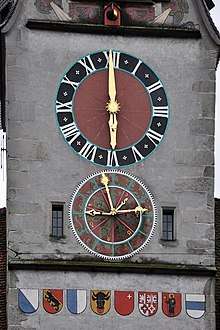 Zytturm, Zug
Zytturm, Zug Sion
Sion
United Kingdom
- A group of four famous astronomical clocks in the West Country, dating from the 14th and 15th centuries, all of which show the 24-hour time and the moon phase:
- Exeter. The Exeter Cathedral astronomical clock (c. 1484)
- Ottery St Mary. The Ottery St Mary astronomical clock (15th century)
- Wells. The Wells Cathedral clock (1386–1392)
- Wimborne Minster. The Wimborne Minster astronomical clock (14th century)
- Durham. Prior Castell's Clock in Durham Cathedral, installed between 1494 and 1519.
- Hampton Court Palace. The Hampton Court astronomical clock (1540) is on the interior façade of the Main Gatehouse. It is a fine early example of a pre-Copernican astronomical clock.
- Leicester. The Leicester University astronomical clock (1989) is on the Rattray Lecture Theatre opposite the Physics department.
- London. The astronomical clock of Bracken House was installed in 1959.
- Snowshill. The Nychthemeron Clock, installed in the garden of Snowshill Manor.
- St Albans. A modern clock dating from 1995 built from notes by Richard of Wallingford held in the Bodleian Library, Oxford. On display in St Albans Cathedral.
- York. The York Minster astronomical clock, an astronomical clock installed in 1955 as a memorial to airmen killed in World War II, shows the positions of the sun and stars from the perspective of a pilot flying over York.
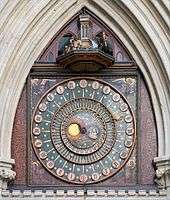 Wells Cathedral
Wells Cathedral Exeter Cathedral
Exeter Cathedral Ottery St Mary
Ottery St Mary Hampton Court
Hampton Court.jpg) York Minster
York Minster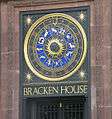 Bracken House, London
Bracken House, London
See also
- Astrolabe
- Astrarium
- Clock of the Long Now, also called the 10,000-year clock
- Torquetum
Notes
- PBS (2013). NOVA: "Ancient Computer". Retrieved 4 April 2013.
- Dr. Kasem Ajram (1992). Miracle of Islamic Science, Appendix B. Knowledge House Publishers. ISBN 0-911119-43-4.
- "Early Orientalism". google.com.my.
- Hill, Donald R. (May 1991). "Mechanical Engineering in the Medieval Near East". Scientific American: 64–69. (cf. Hill, Donald R. "Mechanical Engineering". Archived from the original on 25 December 2007. Retrieved 22 January 2008.)
- David A. King (1983). "The Astronomy of the Mamluks", Isis 74 (4), p. 531-555 [545–546].
- White, Lynn Jr. (1966). Medieval Technology and Social Change. Oxford Press., p.122-123
- Whyte, Nicholas. "The Astronomical Clock of Richard of Wallingford". personal website. Archived from the original on 4 May 2008. Retrieved 24 April 2008.
- Burnett-Stuart, George. "De Dondi's Astrarium". Almagest. Computastat Group Ltd. Archived from the original on 30 May 2008. Retrieved 21 April 2008.
- Burnett-Stuart, George. "Astronomical Clocks of the Middle Ages: A guided tour". Almagest. Computastat Group, Ltd. Archived from the original on 2 April 2008. Retrieved 24 April 2008.
- "National Museum of Natural Science -> Exhibition -> Permanent Exhibits". nmns.edu.tw. Archived from the original on 24 February 2018. Retrieved 9 October 2015.
- Howard R. Turner (1997), Science in Medieval Islam: An Illustrated Introduction, p. 184. University of Texas Press, ISBN 0-292-78149-0.
- Routledge Hill, Donald, "Mechanical Engineering in the Medieval Near East", Scientific American, May 1991, pp. 64–69. (cf. Donald Routledge Hill, Mechanical Engineering Archived 25 December 2007 at the Wayback Machine)
- "A History of Engineering in Classical and Medieval Times". google.com.my.
- "Time to Celebrate". google.com.my.
- "Ancient Discoveries, Episode 11: Ancient Robots". History Channel. Retrieved 6 September 2008. Cite journal requires
|journal=(help) - "Mughal and other Indian paintings from the Chester Beatty Library". google.com.my.
- Ahmad Y al-Hassan & Donald R. Hill (1986), Islamic Technology, Cambridge, ISBN 0-521-42239-6, p. 59.
- "Innsbruck (Autriche)". patrimoine-horloge.fr (in French). Retrieved 10 March 2020.
- "Astrolabiumuhr". peuerbach.at (in German). Retrieved 15 March 2020.
- "Senzeille (Belgique)". patrimoine-horloge.fr (in French). Retrieved 10 March 2020.
- "Litomyšl astronomical clock". Czech Tourism. Retrieved 8 March 2020.
- "Orloj Šumava Hojsova Stráž". Retrieved 24 March 2020.
- "About Hop and Beer temple in Žatec". zamek-steknik.cz. Retrieved 11 March 2020.
- "L'Horloge de la Création dans l'église Saint-Léger à Munster". petit-patrimoine.com/ (in French). Retrieved 10 March 2020.
- "Astronomical Clock in Bantumi". Georgia About. Retrieved 12 March 2020.
- Repository for the Rostock Astronomical Clock
- "Die Astronomische Uhr". Stadtgemeinde Stendal (in German). Retrieved 14 March 2020.
- "Astronomische Uhr". koelner-planetarium.de/ (in German). Retrieved 15 March 2020.
- "Festo Harmonices Mundi". 24hourtime.info. Retrieved 14 March 2020.
- "Die astronomische Uhr am Rathaus". schramberg.de (in German). Retrieved 14 March 2020.
- "Clockworks and Clock Museum". Székesfehérvár Turizmus. Retrieved 11 March 2020.
- "The Astronomical Clock in Piazza Grande". Around Arezzo. Retrieved 7 March 2020.
- "Municipio e loggetta municipale". comune.bassano.vi.it (in Italian). Retrieved 8 March 2020.
- Brescia, Italy – The clock tower at flickr.com
- "Stock Photos, Royalty-Free Images and Vectors". shutterstock.com.
- "Ein Friedhofsrundgang". Meraner Stadtanzeiger (in German). No. 21. 31 October 2014. p. 6. Retrieved 8 March 2020.
- "Piazza Tre Martiri". Rimini Turismo. Retrieved 8 March 2020.
- "Palazzo comunale e Torre Civica". Soncino Turismo (in Italian). Retrieved 8 March 2020.
- "Porta Oscura e Torre dell'Orologio". Turismo Trapani (in Italian). Retrieved 8 March 2020.
- "Clock Towers". Maltese History & Heritage. Retrieved 12 March 2020.
- Slovenský orloj v Starej Bystrici Archived 10 December 2013 at the Wayback Machine, municipality official website (in Slovak)
- Pražský orloj – Orloje v zahraničí (Prague Astronomical Clock – Foreign clocks, in Czech)
- "Cuando León era dueño del tiempo". Diario de León (in Spanish). Retrieved 12 March 2020.
- "Schaffhausen (Suisse)". patrimoine-horloge.fr (in French). Retrieved 9 March 2020.
- "Sion (Suisse)". patrimoine-horloge.fr. Retrieved 9 March 2020.
- "Soleure – Solothurn (Suisse)". patrimoine-horloge.fr (in French). Retrieved 9 March 2020.
- "Winterthur (Suisse)". patrimoine-horloge.fr (in French). Retrieved 9 March 2020.
References
- Needham, Joseph (1986). Physics and Physical Technology, Part 2, Mechanical Engineering. Science and Civilization in China. 4. Taipei: Caves Books Ltd.
- North, John (2005). God's Clockmaker, Richard of Wallingford and the invention of time. Hambledon and London.
- Sørnes, Tor (2008). The Clockmaker Rasmus Sørnes. Borgarsyssel Museum, Sarpsborg, 2003 Norwegian edition, and 2008 English edition (available from the museum).
- King, Henry (1978). Geared to the Stars: the evolution of planetariums, orreries, and astronomical clocks. University of Toronto Press.
External links
| Wikimedia Commons has media related to Astronomical clock. |
- The search for Rasmus Sørnes 4th clock
- Burnett-Stuart, George. "Astronomical Clocks of the Middle Ages: A guided tour". Almagest. Computastat Group, Ltd. Archived from the original on 2 April 2008. Retrieved 24 April 2008.
- Prague Astronomical Clock
- The Annosphere, a contemporary astronomical clock
- Les Cadrans Solaires (Sundials), also showing European astronomical clocks (in French)
- The horologium, the local astronomic monumental clock from any spot on earth
- THE ASTRONOMICAL CLOCK OF THE ST.-MARIEN-KIRCHE IN ROSTOCK
- MoonlightClock.com – Handmade Astronomical Clocks
- Festraets’ astronomical clock
- Simple astronomical clock for Android platform
